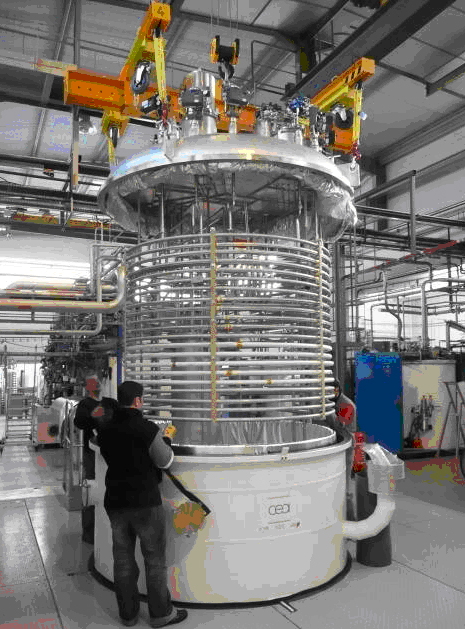The thermal loads from the Deuterium-Deuterium nuclear reactions, the current losses in the coils, and the eddy currents in the structures, induce high variable heat loads. The cryogenic system shall absorb the transient loads encountered in large tokamaks and maintain the superconducting magnets at 4.4K. In JT-60SA, the peak loads could reach up to twice the average refrigeration power over one cycle. Different methods are under study to protect the system from an overcharge during a pulse load, to optimize the refrigeration capacity and to reduce the investment and operation costs. The aim of the research work is to ensure safe operation with a refrigeration capacity close to the average power over one cycle.
Smoothing methods applied upstream the refrigerator, at the cryo-distribution level are being explored and validated with a versatile test bench built at the laboratory: HELIOS (HElium Loop for hIgh lOads Smoothing, Figure 1) is a 1/20 scaled down mock up of the cryo-distribution of the central solenoid superconducting magnets. The HELIOS loop is driven by forced convection with Supercritical helium at 4.4K under 5 bar (secondary loop, see schematic). The experimental investigations have brought a better understanding of the transient phenomenon induced by the heat pulses. This large installation can reproduce conditions of pressure, temperature and transport times, similar to those expected in the cooling circuits of the central solenoid superconducting magnets of JT-60SA.

Figure 1: HELIOS loop in the multi-test cryostat at SBT.
The first experimental campaigns were dedicated to commissioning the test loop and calibrating the instrumentation. The first pulse scenarios were tested under different configurations. The thermal buffer operation has been validated (Figure 2): the peak loads representative of the tokamak operation have been reproduced and smoothed before they arrive in the refrigerator, by means of a saturated helium bath ( thermal reservoir, see schematic). The stored energy in the reservoir induces an evaporation of helium and a mass flow to the refrigerator. The latter is regulated (see schematic) and remains within the available refrigerator capacity limits. For the Japanese reactor, the peak load of about 12kW can be absorbed by the system with a refrigeration capacity of 6KW (average power over one cycle) and with a thermal reservoir of about 7m
3. Investigations have started to explore other modes of operation and to find proper smoothing methods with dedicated controls.

Figure 2: The thermal reservoir stores the energy deposited at the beginning of the cycle and releases it progressively to the refrigerator.
 Operation of the HELIOS loop
Operation of the HELIOS loop This loop is a mock up of the cooling circuits of the magnets. It is a secondary loop that exchanges heat with the primary loop of the refrigerator though 2 heat exchangers, immersed in a thermal reservoir at 4.3K. The flow is driven by a cold centrifugal circulator with a mass flow of 32g/s. It takes about 10 minutes for one helium particle to travel the complete loop.
In order to smooth the thermal loads, the amplitude shall be reduced and the phase shifted so the arrival of the loads to the refrigerator is delayed.
The high pulsed loads are applied on the secondary loop during the first 170 seconds of the 30 minute cycle, and then they are stored in the loop and in the thermal helium reservoir. The energy is released progressively to the refrigerator during the remaining time of the cycle, before another cycle starts. Instrumentation can characterize the thermo-hydraulic evolution (temperature, pressure, mass flow) both of the loop and of the thermal reservoir.